Ancient Technologies: Analyzing the Artifacts of the Past
Katrina Worley; Jennifer M. Zovar; and B. Jacob Skousen
Learning Objectives
- Describe the development of a variety of ancient technologies
- Identify appropriate methods of archaeological analysis for stone, ceramic, bone, metal, textile, and other types of artifacts
- Evaluate the kinds of questions archaeologists can address through artifact analysis
- Describe how experimental archaeology and ethnoarchaeology can help archaeologists to better understand the technologies of the past
The most popular image of an archaeologist may be of Indiana Jones racing from a collapsing temple, clutching a golden idol in his hands. By now, you probably recognize that this image is not accurate. This is an example of a looter, not an archaeologist; he is stealing one valuable object as an entire archaeological site collapses around him, and he has clearly not consulted with the local Indigenous community. Nevertheless, the idea that archaeology is about finding cool artifacts for display in museums or other contexts persists in the public imagination and through popular media (see Psuedoarchaeology chapter). One of the most common questions archaeologists are asked is, “What’s the most interesting thing you’ve ever found?” This is a difficult question to answer because the artifact itself is not what is interesting to the archaeologist. What is interesting to the archaeologist is what an artifact can teach us about how people lived in the past.
In this chapter, you will learn about a variety of ancient technologies and see how archaeologists study them to learn about past societies. Note that we are focusing here on the analysis of artifacts, portable objects that were made and used by human beings. We’ll review the methods used to study a variety of tool types by different methodological specialists. We conclude with a reflection on the roles of experimental archaeology and ethnoarchaeology in artifact analysis.

First, however, let’s reflect on what we mean when we talk about ‘tools’ in the archaeological record. A tool is something that is made for a specific purpose. That purpose is often practical — to skin an animal, to carry water, to warm your body — but a more expansive understanding may also consider tools that are made for decorative or religious purposes. Tool-making is sometimes called a ‘defining characteristic’ of human beings, although we now know that chimpanzees and other primates (and even some birds!) will sometimes make and use simple tools (Figure 1). For example, Jane Goodall famously observed chimpanzees preparing sticks to harvest termites from a termite mound, and since then, they have even been seen making spears to hunt bushbabies. (See Tool Use from the Jane Goodall Institute for a short video introduction to the many tools chimpanzees have created and used.) However, it is also true that tool manufacture and use is an essential part of being human. Some scholars have even suggested that the evolution of human language may have taken place in part because our ancestors needed to be able to talk about their tools and teach each other how to make them (e.g. Morgan et al. 2015).
It is likely that early hominin tool-makers would have made simple, impromptu tools similar to those of the chimpanzees, but they would have decomposed and not been preserved in the archaeological record. Instead, the oldest tools we see are stone tools, called lithics by archaeologists. Other common tool types include pottery and other ceramics as well as tools and other objects made of bone or shell. Depending on the cultural context, metal artifacts may also be discovered, and textiles and other perishables may be found if the preservation is good. The first step in any analysis begins by dividing the collected artifacts into a rough typology based on material — separating stone, ceramic, textile, etc. Since different techniques are used to analyze different types of materials, archaeologists tend to specialize. In this chapter, Jacob Skousen is our specialist on lithic analysis, Jennifer Zovar is our specialist on ceramic analysis, and Katrina Worley is our specialist on textile analysis.
Lithic Analysis
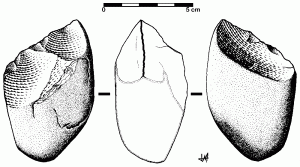
Lithic, or stone, tools and their byproducts are among the most commonly recovered artifacts from archaeological sites, in large part because these artifacts are imperishable. As a result, lithic artifacts are also the oldest known artifacts in the world. (See Special Topics: The Earliest Stone Tools, below.) The earliest lithic artifacts, called Oldowan tools (Figure 2), are roughly-flaked butchering implements that were made by our earliest human ancestors at least 2.6 million years ago (Sahle & Gossa, 2019).
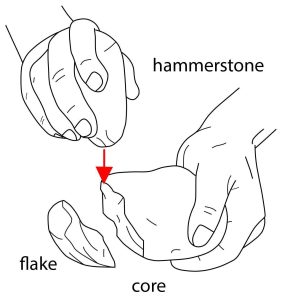
Archaeologists generally divide stone tools into two types: chipped- or flaked-stone tools and groundstone tools. Chipped-stone tools are made from chert (aka flint) or obsidian (volcanic glass), both materials that have a predictable fracture pattern. When a chunk of chert or obsidian (called a core) is struck in a particular way with a stone or piece of antler or wood (called a hammer), a flake is produced (Figure 3). Flakes, or long, linear slivers of the material, can be used as tools due to their sharp edges or further modified into other tools; conversely, the core can be shaped into a particular tool. One of the most recognizable chipped-stone tools are spear or arrow points, which were hafted onto the ends of sticks or canes.
Special Topics: The Earliest Stone Tools
Humans and their immediate ancestors have been using stone tools for millions of years. The oldest widely accepted stone tool making tradition, dating to about 2.6 to 1.5 million years ago, is called Oldowan, named after Olduvai Gorge in modern day Tanzania where these tools were first identified (Sahle and Gossa, 2019). Oldowan tools consist of minimally flaked stone cobbles (often called choppers), flakes, and cobbles with no modification (see Figure 2). Use-wear studies show the so-called choppers and the flakes that came from them were used for cutting and scraping a variety of animal and plant material (Lemorini et al., 2014). Archaeologists are not certain which hominin species made and used these tools since many hominins existed during this time period; a few possibilities include Australopithecus africanus, Australopithecus garhi, Homo habilis, and Homo erectus/ergaster.
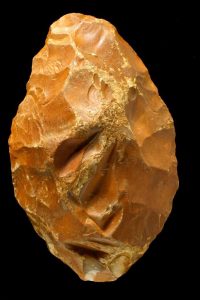
A new stone tool making tradition, called Acheulean (named for the town of Saint-Acheul in France), developed around 1.76 million years ago (Lepre et al., 2011). The most distinctive Acheulean tools are large stone bifaces (tools flaked on both sides), better known as handaxes (Figure 4); other Acheulean tools include scrapers, choppers, and cleavers. Acheulean handaxes are teardrop-shaped, more symmetrical than Oldowan tools, and sharp on all edges, which indicates that making these tools took a greater degree of planning. Some of the earliest Acheulean tools are found with Oldowan style tools, but it is unclear whether the Acheulian tradition developed from the Oldowan tradition or originated elsewhere. Regardless, Acheulean tools continued to be used after the Oldowan tradition fell out of use, or until about 250,000 years ago. Use-wear studies indicate that Acheulean handaxes were used for a variety of purposes, including butchering (Zupancich et al., 2018). Homo erectus/ergaster were likely the primary makers of Acheulean tools, though it is possible that later hominin species also made and used these tools.

Around 250,000 years ago, as the Acheulean tradition waned, the Mousterian stone tool tradition (named after the Le Moustier Cave site in France) developed. Mousterian tools, which are found throughout Europe and western Asia, were made and used by Neanderthals (Biagi and Starnini, 2014). Unlike the tools from earlier traditions, Mousterian tools are far more refined. These tools were made from flakes produced using what archaeologists call the Levallois technique (a particular way of preparing cores that produce flakes of a predetermined size and shape) (Figure 5). Despite the refined quality of Mousterian tools, they are variable, leading archaeologists to consider the Mousterian tradition as a flexible toolkit (Turq et al., 2013). The Mousterian tradition disappeared around 40,000 years ago, about the same time Neanderthals became extinct, after which rapidly spreading groups of Homo sapiens all around the world developed unique stone tool types, styles, and traditions distinctive to particular regions and time periods (e.g., Shea, 2015).
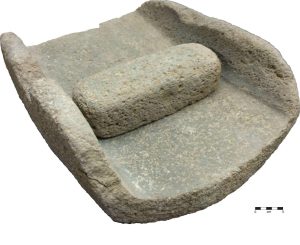
Groundstone tools, on the other hand, are made from sedimentary, igneous, or metamorphic rock and shaped by pecking or grinding. Some groundstone tools were used to grind or pound seeds, nuts, and other plant material or minerals for pigments or paints; others were shaped into axes, plummets, or ornaments. Common groundstone tools in the Americas are a mano (handstone) and metate (lapstone), which were used together to grind seeds or maize (Figure 6).
How to Analyze Stone Tools
Archaeologists who analyze lithic artifacts begin by sorting these artifacts into chipped and ground stone objects. They then further divide either chipped and groundstone artifacts into different artifact types. The two most basic types of chipped stone artifacts include debitage and tools, which are then further broken down into more specific categories. (For debitage, this includes flakes, cores, and shatter; for tools this includes arrow or spear points, knives, and scrapers). Specific types of groundstone artifacts are generally more varied; some more common types are manos, metates, abraders, hammerstones, anvils, and fire-cracked rock. When the artifacts in an assemblage are divided into the desired groups, they are further classified by material type, and then counted and weighed. Other more detailed analyses are often performed, some of which are described below.
Debitage analysis

A common type of flaked-stone tool analysis is examining debitage (pronounced deb-eh-taj), or the waste produced when making a chipped-stone tool. Debitage can help archaeologists determine the kinds of tools that were made at a particular archaeological site. Common types of debitage include flakes, shatter, and cores. As stated earlier, a flake is a long, linear sliver of the chipped stone material and can be identified by a bulb of percussion, striking platform, and sharp edges (Figure 7). Shatter refers to the blocky fragments of chipped stone material created from the hammer crushing the parent material during the flaking process. Cores are the original nodules of parent material from which tools were created.
Stylistic Analysis

Identifying styles or “types” of stone tools requires grouping stone tools with similar attributes. Styles are typically associated with a time period, geographical region, and/or function. Stylistic analysis is regularly conducted on spear and arrowheads. Most archaeologists, for example, know that a “Clovis point” (Figure 8), a particular “fluted” lanceolate spearpoint found throughout North America, dates from between roughly 12,000 and 11,000 BCE (Smallwood & Jennings, 2015).
Microwear analysis
Microwear, or usewear, analysis is a way to understand exactly how chipped stone tools were used. This process involves replicating the chipped stone tool, using it in specific ways (e.g., cutting, scraping, piercing, drilling) on specific materials (e.g., wood, bone, plants, animal hide or meat), examining microscopic wear patterns on the used edge of the tool, and comparing the use wear on the replicated tool to that of tools recovered from archaeological contexts (Keeley, 1980).
Sourcing
Lithic analysts almost always try to identify the geographical location, or source, from which lithic material was obtained to make stone tools. Sometimes this can be done by macroscopic comparisons of the material type to raw sources obtained from certain locations. In other cases, a microscopic analysis of the crystals or a chemical analysis of the composition of a material is necessary to determine its source.
What can we learn from stone tools?
Archaeologists learn numerous things from lithic artifacts. They can learn how past people procured and processed food. Some lithic tools, for instance, were used for hunting (arrow or spear points) or fishing (net weights), while others were used for cutting meat (knives), pounding and

grinding seeds or grain (mano and metate, mortar and pestle [see Figures 6 and 9]), or breaking open nuts (nutting stone and anvil). Lithic tools can also tell archaeologists about ancient technologies. For example, hammerstones and anvils were used to make other flaked tools, and sandstone abraders were used to shape bone and shell implements. The material from which stone tools were made can shed

light on the procurement of certain lithic materials and the movements of the people who obtained and distributed them. Certain types and styles of stone tools can provide information on the chronology of a site; Clovis points, mentioned earlier, date to the Paleoindian period (Smallwood & Jennings, 2015). Some stone tools can even provide information on group identity, status differences, and religious practices; Classic period Maya “eccentric” flints (Figure 10) were probably made by specialists, and some were used as symbolic weapons to protect sacred places and buildings from supernatural threats (Fasquelle et al., 2016).
Bone/Shell Artifacts
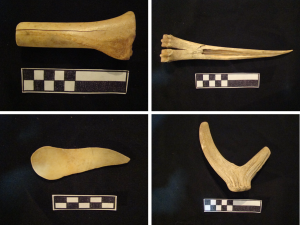
After lithics, bone tools are the oldest found in the archaeological record, dating back at least 1.5-2 million years ago. (See Bone Tools for an early example). Another chapter (Ancient Foodways) discusses how archaeologists examine the unmodified animal remains that are the result of ancient meals, but here we focus only on the bone and shell items that have been shaped into tools. Bone and shell can be chipped, cut, ground, or polished into a number of different forms. Common bone tools include hoes and other agricultural implements; scrapers or other tools for processing food; fish hooks; weaving tools, awls, needles, or other sewing equipment; musical instruments (like flutes); and jewelry, beads, or other adornments (Figure 11).
Analyzing Bone and Shell Artifacts
There are two parts to analyzing artifacts made of shell and bone. First, an archaeologist considers the same sorts of attributes that are recorded for any artifact — the size and shape of the tool, manufacturing techniques, its style or “type,” and any microwear. This can help us better understand the technology of tool production and the context of its use. For example, more than 60 bone tools that were found in Contrebandiers Cave, Morocco, show evidence of being used for clothing manufacture approximately 120,000 years ago. Archaeologists made this determination because the style and usewear are consistent with tools used for working with leather and fur in other contexts (Hallett et al., 2021). Likewise, studies of the marks on bone tools dating to about 35,000 years ago from the Kimberley region in Australia show that they were used for a variety of purposes, including crafting items from plant-fiber and resin as well as hunting and fishing (Langley et al., 2021).

In addition to analyzing tool technology, however, archaeologists will also look at the bone itself. They try to identify the skeletal element (specific bone) from which the tool is made as well as its species. If there is minimal modification (as with the scapula of a large mammal used as a hoe), it may be relatively easy to ascertain the species. However, if the bone has been extensively shaped and polished (as with a point, needle, or fishhook), it may be nearly impossible from visual examination alone (Figure 12). Newer techniques can analyze biomarkers in the bone to identify species of origin (e.g. Bradfield et al. 2018). If some species tend to be over- or under-represented in the tool assemblage, it may provide information about crafting choices or ritual associations between particular tools and particular animals. Likewise, if a bone or shell artifact is made from a species that is not local, this can inform archaeologists’ understanding of travel and/or trade routes. For example, the presence of marine shell beads, gorgets, shell cups, and other prestige artifacts in higher status households and ritual contexts at the site of Cahokia (in what is today the state of Illinois) show that high-status people there were connected through complex trade routes to the Gulf Coast (e.g. Trubitt 2005).
Ceramic Analysis
Unlike stone and bone tools, ceramics are not found in the archaeological record until after the evolution of modern Homo sapiens. (See Special Topics: A [Very] Short Ceramic History, below.) However, once they appear, they are often among the most common artifacts. Archaeologically, ceramic refers to any material made by humans out of clay and subsequently fired, heated to a stage that the clay chemically changes and hardens (Sinopoli 1991). Ceramics are uniquely useful to archaeological investigations because pots and other fired clay objects are found around the world and preserve remarkably well; they break, but do not decompose, and broken potsherds are not often collected by looters (Rice 1987). Moreover, because they are ordinary, daily use artifacts, ceramics are found in a variety of contexts and thus can inform archaeologists about many activities related to their use and manufacture.
Special Topics: A [Very] Short Ceramic History
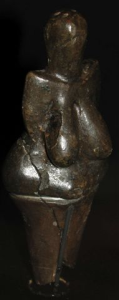
Surprisingly, the earliest ceramics were not practical tools, but ritual objects or works of art. Venus figurines, found across Europe from approximately 35,000-20,000 years ago, were made out of a variety of materials, including soft stone, bone, or fired clay. The oldest known ceramic artifact is the Venus of Dolní Vĕstonice, a small statue (less than 4.5 inches in height) that was discovered in 1924 in what is today the Czech Republic. This statuette dates to approximately 31,000-27,000 years ago (Figure 13). In addition to the Venus, there were also clay figurines of animals, including mammoths and lions, at the site.
As demonstrated by the Venus and other figures, people clearly knew that clay could be fired to create a hardened material much earlier than we begin seeing pottery in the archaeological record. In fact, the oldest known pottery is not found until significantly later, in what is today China. Xianrendong Cave, in China’s Jiangxi Province, was occupied by a population of hunters and gatherers, who used the resource through the Ice Age. The oldest sherds, which date to approximately 20,000 years ago, show signs of burning, suggesting they were likely used for cooking (Wu et al., 2012). Other early pottery is found in East Asia, especially what is today China and Japan, long before the advent of agriculture.
Nevertheless, pottery does not become very common anywhere in the world until about 10,000 years ago, when people began experimenting with domestication of plants and animals. This is likely because pottery is not very practical for hunting and gathering communities, which tend to be more nomadic. Baskets and skin bags (which are more likely to decompose and disappear from the archaeological record) are far lighter and more efficient for transporting goods.
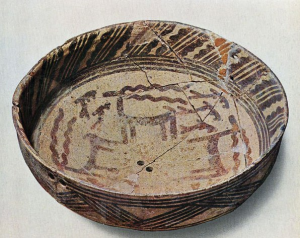
However, about 10,000 years ago, in many different parts of the world, people started interfering with natural plants and animals so much that they changed biologically, becoming dependent on humans at the same time that humans became dependent on them. This process, called domestication (and sometimes referred to as the Neolithic Revolution), was linked with increased sedentism, as well as the need to store crops for later consumption. In this context, pottery was a good way to store surplus food, protecting it from rodents or other pests who might eat it. Pottery also provided a way to help process new food products, as seen through the discovery of early ceramic cheese sieves (McClure et al., 2018).
It was at this stage that a variety of different types of pottery began to appear, as different cultures developed their own styles and decorative techniques. In Mesopotamia, some of the earliest pottery is made in the Hassuna style (Figure 14), dating to approximately 7,000-9,000 years ago, shortly after some of the earliest domestication.
Pottery Manufacture and Technology
For a potter in ancient times, the first step to manufacture was finding and preparing the clay. Although clay occurs naturally, in order to make a high quality pot, it is necessary to remove unwanted particles and add in more desirable additives, known as temper. Temper can include sand containing quartz and other minerals; crushed up rock; grasses or other organic materials; or ground shell, bone, or pottery fragments. A skilled potter knows that different kinds and quantities of temper prepare the clay for different uses (Rye 1981). For example, a pot for cooking may be created with a rougher temper, which allows it to heat and cool more effectively without cracking.
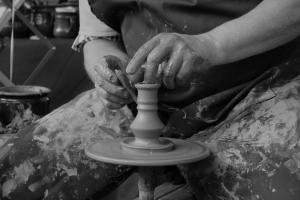
As anyone who has ever played with Play Doh knows, you can mold clay in a variety of different ways — pinch pots, the coil method, using a mold, building with slabs, etc. Different techniques for forming the vessel may be practical, but can also reflect cultural or stylistic preferences. Likewise, changes may result from the introduction of new technology, like the pottery wheel (Figure 15). Once the basic form of a vessel is made, secondary or decorative forming techniques may be added before it is fired. Techniques may include beating, scraping, smoothing, burnishing, and polishing; decorative motifs may be cut, carved, or molded onto the vessel. The surface may be covered with slip, glaze, or painted decoration.

Firing techniques also vary by cultural group and chronological period. If you have taken a ceramics class, you probably fired your pieces in an enclosed kiln, which provides a controlled, even heating environment. However, it is possible to create pottery without a kiln. In an open fire method, the pots are mixed with the fuels on the surface of the ground or in a small pit and then burned. Because it is more difficult to control the atmosphere, careful placement prior to firing is necessary to ensure an even heating environment. Even under ideal conditions, some pots will crack, break, collapse, or fire unevenly. It depends on the combination of the heating atmosphere, the rate of heating, and the maximum temperature (Figure 16).
How to Analyze Ceramics
An understanding of the basics of pottery manufacture helps archaeologists to analyze the resulting ceramics, which are often broken or deposited in a refuse pit. Archaeologists work back from the discarded artifact to better understand the context of its use and creation. Different approaches to archaeological analysis include an analysis of form and function, a stylistic analysis, or a characterization study. The kinds of analyses an archaeologist employs depend on the particular research question they are asking, and many investigations require multiple analyses. (See Case Studies: Ceramic Analysis into Post-Collapse Societies in Bolivia.)
Form and Function Analysis

The shape and form of an artifact can give us some clues about its function, or how it was used. In some cases this may seem obvious — a pitcher is clearly used for pouring liquid, while a large pot with burn marks must have been used for cooking. In other cases, however, the function of a vessel is not as clear. What hypotheses do you have about the uses of the pots pictured at left? (Figure 17).
The first step to this sort of analysis is to create a typology, grouping like objects together with other like objects. This is the sort of thing you likely do without thinking about it when you organize your own kitchen. You may, for instance, put the plates on one shelf, the cups on another, etc. However, it becomes trickier when you are organizing items for which you lack cultural context. The people who used the pottery may have had a different classification system than the archaeologists who are studying it. For example, in a recent study, researchers found that there were significant differences in the way that archaeologists and Indigenous potters sorted a collection of ceramic sherds, with the potters often noting specific characteristics that the archaeologists did not recognize (Borck et al., 2020). In addition, it’s important to remember that the same pot may have been used for different purposes over the course of its use-life, making simple categorization even more difficult.
Even so, it is usually possible to roughly divide any collection into vessels used for storage, cooking/food-processing, or serving/transfer. From there, additional sorting will depend on the collection. Archaeologists consider a number of attributes, including the shape of the rim, base, or handles, the dimensions of the rim/base, the thickness of the vessel walls, the compactness of the clay, the color, the firing environment, the presence of specific paste inclusions, the type of finish, the presence of glaze or wash, and any signs of usewear.
Stylistic Analysis
In addition, archaeologists may consider stylistic attributes that do not contribute to the function of the vessel itself. Style is often seen as a proxy for cultural identity; shared styles may indicate a close social relationship, while abrupt stylistic changes may indicate some sort of change in social or political organization. Archaeologists may record specific elements or motifs that appear on different pots and consider how they change over time and between sites.
At the same time, there is an old archaeological adage that warns against ‘confusing pots for people.’ This means that we need to be careful about methodological approaches that focus only on the artifact itself without considering what the people who created it were trying to communicate. For example, while Iron Age ceramic styles in Southern Africa were traditionally interpreted primarily as ethnic markers, a more detailed study (incorporating ethnohistory and ethnography) has shown that ceramic style is far more complex (Pikirayi & Lindahl, 2013). Archaeologists need to recognize that pots (and other ceramic vessels) are mobile objects, and that their styles are a form of communication over both time (as novice potters learn from their elders and from experimentation) and space (as people move, vessels are traded, and pots are used in different contexts over their use-life).
Characterization study
While analyses of form, function, and style consider the design of the pot, characterization studies focus on the clay itself. This can be important in identifying the source of the clay as well as the technical choices that potters made in preparing the material. Characterization studies draw on techniques from the physical sciences, focusing on the internal microstructure of the clay. This may include mineralogical studies like petrography as well as chemical characterization. (See Special Topics: Archaeological Chemistry and Artifact Analysis, below.)
Special Topics: Archaeological Chemistry and Artifact Analysis
Archaeology increasingly draws on techniques from the physical sciences to aid in our data collection and analysis. Archaeological chemistry, specifically, is often used to help identify the material composition of an artifact or to help determine where it came from. Instruments like INAA (Instrumental Neutron Activation Analysis), ICP-MS (Inductively Coupled Plasma – Mass Spectrometry), or XRF (X-Ray Fluorescence) may be used to identify chemical composition groups that can be matched to a specific geological provenience. While each of these instruments use a different technology, they all break down the chemical elements present in different materials.

Each material class (ceramics, different kinds of metal, various stones and minerals, etc.) will be somewhat similar in terms of its major elements, but may differ greatly in terms of its trace elements. For example, any ceramic material is primarily composed of silica (SiO2), but will have different amounts of other elements. Pots that are made from the same clay source, however, will be more similar to each other. By using a statistical technique called discriminate analysis, it is possible to identify groups within a selected sample by comparing the presentation of selected elements (Figure 18). For example, using INAA, one group of researchers was able to distinguish authentic high-quality Zisha stoneware (produced during the Ming dynasty from clays near Yixing, China) from imitations that were created later in various European countries, a distinction that is difficult to make from visual observation alone (Zhu et al., 2019).

While INAA has a longer history of use in the investigation of ceramic materials, ICP-MS has become increasingly popular, in part because it is cheaper and somewhat less destructive (Kennett et al., 2002:444). As part of my dissertation research, I (Jennifer Zovar) chose to use Laser Ablation ICP-MS to investigate pottery from Bolivia’s southern Titicaca basin with the support of the Field Museum’s Elemental Analysis Facility. I wanted to see whether pottery from the site of Pukara de Khonkho was produced locally or remotely, helping to clarify the role of trade and other interactions related to ceramic production during the period right before the Inca came into the region. The results showed that most of the tested pottery from the Pukara de Khonkho and surrounding sites fell into the same chemical characterization group, suggesting that they were all produced with local clays, a pattern that did not change after the Inca incursion (Zovar, 2012).
Characterization studies can also be useful in ascertaining the provenience of stone artifacts. For example, as part of that same dissertation research, XRF tests were able to determine the provenience of some of the obsidian flakes found at the site of Pukara de Khonkho. Ryan Williams and John Janusek have also worked together to determine the source of Tiwanaku’s famous monoliths and other stonework (Figure 19). They found that the sandstone and andesite came from various quarries in the surrounding mountains, which are seen as sacred (Janusek & Williams, 2016).
What Can We Learn From Ceramics?
Archaeologists first became interested in pottery to help establish chronologies of archaeological sites. Since pottery styles change slowly over time, the presence of particular styles can help to provide dates for site occupation. In fact, ceramic styles are often used as shorthand for specific archaeological periods. (For example, the Jomon period of ancient Japan – the entire Holocene to ~300 BCE – is named for a specific type of pottery!) In addition, ceramics can be directly dated through thermoluminescence. (See Dating Methods.) The use of ceramics to establish dates and to investigate change over time is still important, but analyses of ceramic material provide far more than a simple catalog of pottery types and technical specifications. Even the most unassuming potsherds contain a wealth of information about subsistence, technology, economy, and identity — as long as archaeologists ask the right questions. (See Special Topics: What Pots Teach Us, below, for some specific examples.)
Special Topics: What Pots Teach Us
People new to archaeology are often surprised at how much information archaeologists can glean from some simple potsherds. There is much more than identifying the cultural group, time period, and basic function of a vessel. Below are just a few (of many) examples of what we can learn from pots.
We can investigate practices of food consumption and preparation by analyzing the residue left on the insides of a pot. This not only touches on what was being prepared, but who was doing the preparation of the food. Early generations of archaeologists often overlooked this sort of study because food preparation was assumed to be the work of women, domestic servants, or others with little power in society (Graff, 2020). Nevertheless, lipids, proteins, and/or microbes that seep into the ceramics can give information about the specific ingredients that were used and how they were prepared. For example, an analysis of lipids found on pottery at the site of Durrington Wells (near Stonehenge) helped to demonstrate that meat (pork & cattle), and dairy products tended to be prepared and consumed in different parts of the site, using different vessels (Craig et al., 2015). Additional examples of residue studies can be explored in How Pottery Offers Glimpses into Ancient Foodways.
We can also look at the process of manufacture to address the division of labor and patterns of trade. Pottery made by individuals for their own household use will leave a different archaeological signature than pottery made by specialists for the purposes of trade. Specialized ceramic workshops at sites in the Indus Valley, for example, suggest elite control of the ceramic trade, while the widespread distribution of Roman amphorae across Europe demonstrates the strength of the Roman trade network (Sinopoli 1991:107-114).
Similarly, the presence or absence of high-quality pottery from a site (or from a certain part of a site) may reflect social organization and social hierarchy. In the Classic Maya period, for example, artistic polychromes (likely commissioned by royal patrons) were painted with images of the sacred ballgame, Maya rulers, deities, and other intricate images. They are exclusively associated with royal palaces and other elite contexts (Reents-Budet, 1994). See Ancient Maya Painted Ceramics for more discussion and some beautiful pictures.
Archaeometallurgy
Archaeometallurgy is the study of metal in archaeological contexts. While relatively rare at older sites, metal artifacts become increasingly important over time. Metal technologies have traditionally been used to categorize past societies, although some of these typologies can be problematic. (See Special Topics Box: Decolonizing the Three Age System, below).
Special Topics Box: Decolonizing the Three Age System
Many non-archaeologists are familiar with the “Three Age System,” which divides human history into three major periods based on the sequential development of technology — the Stone Age, the Bronze Age, and the Iron Age. This model is most often attributed to C. J. Thomsen, a 19th century antiquarian who proposed the chronology based on his work in Scandinavia, and it is broadly applicable across much of Europe and even into parts of the Middle East. The Three Age System is not regularly used in the Americas, Africa, or much of Asia because the chronological sequence of metal use is not the same in these regions. In addition, the system is often linked with problematic, and racist, assumptions of evolutionary progress that do not match the evidence.
For example, although southeast Asia is often overlooked in discussions of technological development, very early bronzework has been recorded in village sites like Ban Chiang, including spear points, adzes, and ornaments dating to about 4,000 years ago. (See Bronze from Ban Chiang, Thailand.) The use of iron and bronze appears to be locally variable across Southeast Asia, and there is little connection between the use of specific metal technologies and patterns of social or political organization. In these contexts, the uncritical application of the Three Age system can confuse understandings of chronology and archaeological histories (Kanjanajuntorn, 2020).
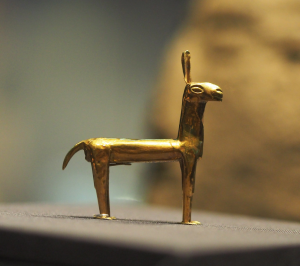
Likewise, the chronology is problematic in the Americas, where iron was never smelted prior to colonization. However, there were a series of highly technologically complex metallurgy traditions (Lechtman, 2014). In South America, the Moche smelted gold, silver, and copper into decorative pieces associated with elite members of society. (See Moche Metallurgy). Metalwork became even more complex with the Inca, who crafted bronze tools as well as intricate golden treasures (Figure 20).
In contrast, in much of Africa, ironmaking was the first metal technology to be widely developed. People of the Nok culture, in what is today Nigeria, built large furnaces for smelting iron around 2,500 years ago (e.g. Fagg Rackham et al., 2017), and iron artifacts were important for trade at the site of Jenné-jeno, in what is today Mali. Metalwork was also an important component of trade in the later southern African kingdoms of Mapungubwe and Great Zimbabwe (e.g. Kim & Kusimba, 2008).
The oldest metal artifacts were made from native metals (e.g. gold, copper, silver), which were formed into decorative bangles, necklaces, bracelets, and other ornamental objects, either through cold hammering or by melting the metal down and shaping it with a mold. The site of Varna, in what is today Bulgaria, provides an example of ancient gold artifacts that were used to designate a social hierarchy approximately 6,500 years ago. (See Mystery of the Varna Gold.)

Metal alloys were later independently developed in many different locations across the world to serve a variety of different purposes. Bronze, for example, is a copper alloy, which is harder and stronger than copper alone. The first alloys mixed copper with arsenic, but true bronze requires tin. The earliest known tin bronze was found in what is today Serbia, and dates to about 6,500 years ago; other early tin bronze is found across the Near East by about 5,000 years ago (Radivojević et al., 2013). Bronze artifacts include axes and spears as well as artistic and/or ritual objects. In Europe and the Near East there is a shift to iron beginning around 3,000 years ago — earlier in some regions — as new technology allowed furnaces to get hot enough to effectively reduce iron ore into iron metal (Figure 21).
Analyzing Metal Artifacts
Just as with any other material, an archaeologist studying metal artifacts would record the basic attributes — size, shape, weight, usewear, etc. However, archaeometallurgists are also specifically interested in determining the specific type of metal that is used. This may begin with a visual examination — looking at weight, density, hardness, color, corrosion, magnetism, etc. For example, iron is magnetic but silver is not, and aluminum is lighter than many other metals. However, more precise investigation may require chemical analysis like X-ray spectroscopy or mass spectrometry. Elemental analysis can help to determine the precise composition of alloys as well as the source of the metals.
This can be important in developing understandings of the technological process that different metal workers follow at different times and in different places, and can also be used to investigate systems of trade and exchange of ideas. For example, in her research into the complex metallurgical technologies of the South American Andes, Heather Lechtman has used elemental analysis to identify the sources used in Andean bronzewear and to investigate changes over time and space (Lechtman, 2014). Throughout the Andes, metals were used to convey high status and religious power — and, although they did not preserve as well, so were textiles.
Textile Analysis
While lithics are the earliest items of human manufacture to survive in the archaeological record, most archaeologists recognize that the earliest tools used by our ancestors would have been made of organic materials such as leaves, twigs, shells, or bone. Organic materials are perishable by nature, and typically don’t survive except under unusual circumstances. One of the groups of perishable artifacts least likely to survive in the archaeological record are textiles.
Textiles can be made from a wide variety of materials, but these fall into two main groups: cellulose fibers from plants and protein fibers from animals. Plant fibers can be found in the stem, bark, or seeds. Those found in the stem are called “bast” fibers and include flax, hemp, dogbane, milkweed, and nettle. Cotton is the most common seed fiber in both the modern and ancient worlds, but string can be made from the fibers surrounding other seeds. Fibers that come from animals include wool and hair from sheep, goats, llamas, camels, and a wide variety of other mammals, as well as silk fibers from the cocoon of the silk moth. Leather and hides also come from animals, but are usually a by-product of hunting or slaughtering livestock for meat. Wool and hair fibers don’t require that the animal be killed. Originally the wool would have been collected from naturally shedding animals. Shearing the animals is a process that comes with domestication.
The manufacture of a textile typically begins with a strand of a flexible or semi-flexible material. This might be a relatively unmodified strip of bark or a stalk of grass, or it might be a strand of fibers that have been processed. Grass or bark fibers in their more or less natural states would be relatively stiff, so items made from unmodified fibers are less foldable. To make the resulting fabric more flexible, the fibers are split, beaten, crushed, or otherwise processed. This separates the individual fibers from the woody matrix and makes them softer and more flexible, but also allows them to decay more quickly. Animal fibers such as wool from sheep need only be shorn from the animal, or collected if the animal sheds its wool naturally. Twisting the softer, more processed fibers creates a flexible cord or string, and a fabric structure created from these processed fibers is more flexible. Some structures have rigid elements in one direction, but flexible in the other. This allows the item to have a degree of rigidity but still be folded or rolled for storage or transportation.
Making string
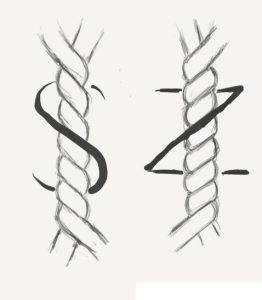
Both cordage and spun thread are made by twisting the fibers. The difference is in how the short fibers are joined to make longer lengths. Cordage has spliced joins (bundles of fibers are overlapped in groups), while yarn has a continuous overlap of fibers, but those details are difficult to see especially when looking at fragmentary artifacts. The fibers can be twisted together in two directions, referred to as “S” and “Z” (Figure 22). These initial strands can then be used as is, or they can be twisted around each other to form “plied” yarns. The number of plies can vary significantly, but most archaeological textiles are made with single strands, two-ply, or three-ply yarns. Careful examination of a textile (or a cast of the textile in mud or clay) can help determine the structure of the yarn or cord used to make it (Figure 22). (See Special Topics: Textile Structures, below, for more details on the weaving process.)
Special Topics: Textile Structures

Once the cordage/yarns/threads are made, these can be manipulated into a variety of simple and complex structures. Woven fabrics have two systems of threads:
one set runs the length of the fabric (the warp)
the other from side-to-side at right angles (the weft or “woof” in the older terminology).
Twined fabrics have two or more wefts which are twisted around each other as they cross the width of the warp, or sets of warps that are twisted as the wefts are passed through. Plaited fabrics have a single system of threads; each thread moves on a diagonal from one side to the other, then turns at the edge and crosses back in a zig-zag path along the length of the plait/braid. If an edge of the fabric where the element turns is present, the difference between a woven fabric and a plaited one can easily be seen (Figure 23).
Other textile structures use a single element that forms knots or stitches. Knotted and looped nets are used for a variety of items from carrying bags and hammocks to hunting and fishing nets.
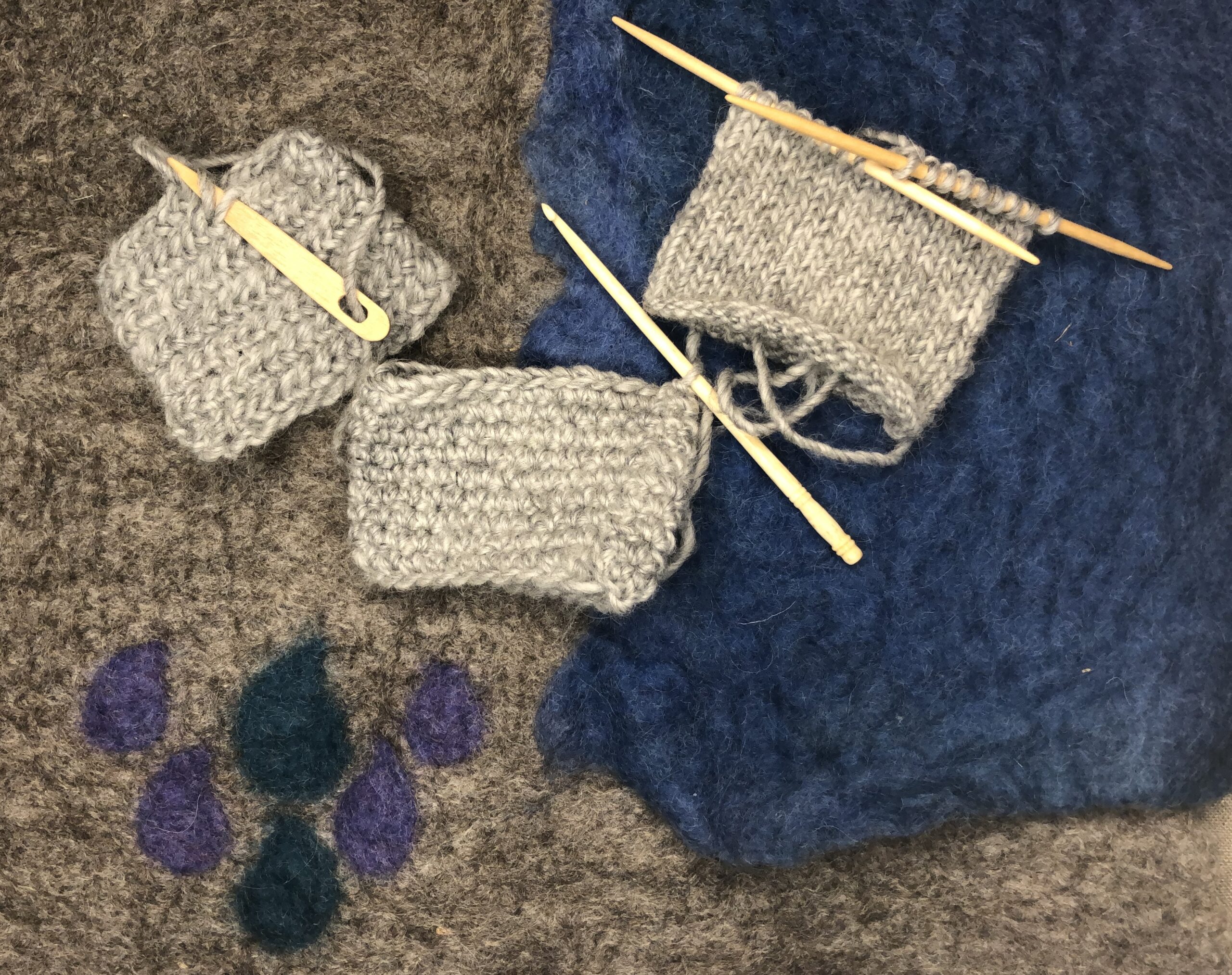
Nalbinding is an ancient technique used for garments in many parts of Northern Europe. It is a form of looped netting and is done with a single eyed needle of either bone or wood, knitting is done with two or more straight needles, and crochet is done with a single hook. The fabric created is warm, flexible, and comfortable for hats, socks, mittens and similar items. Knitting and crochet are much more recent techniques and are used for similar purposes as nalbinding (Figure 24).
Sprang is a form of plaiting or braiding with a fixed warp and is used to create elastic fabrics for hairnets and similar items.
Felt is made from compressing wool fibers to form a sheet of interlocking fibers (Figure 24). It is made with loose wool which is distributed in an even layer and then subjected to heat, moisture, and agitation in the presence of an alkaline substance such as soap. Felt can be made in sheets and cut to shape, or it can be formed around molds and patterns to create three-dimensional items such as boots or shoes.
Evidence of Textiles in the Archaeological Record
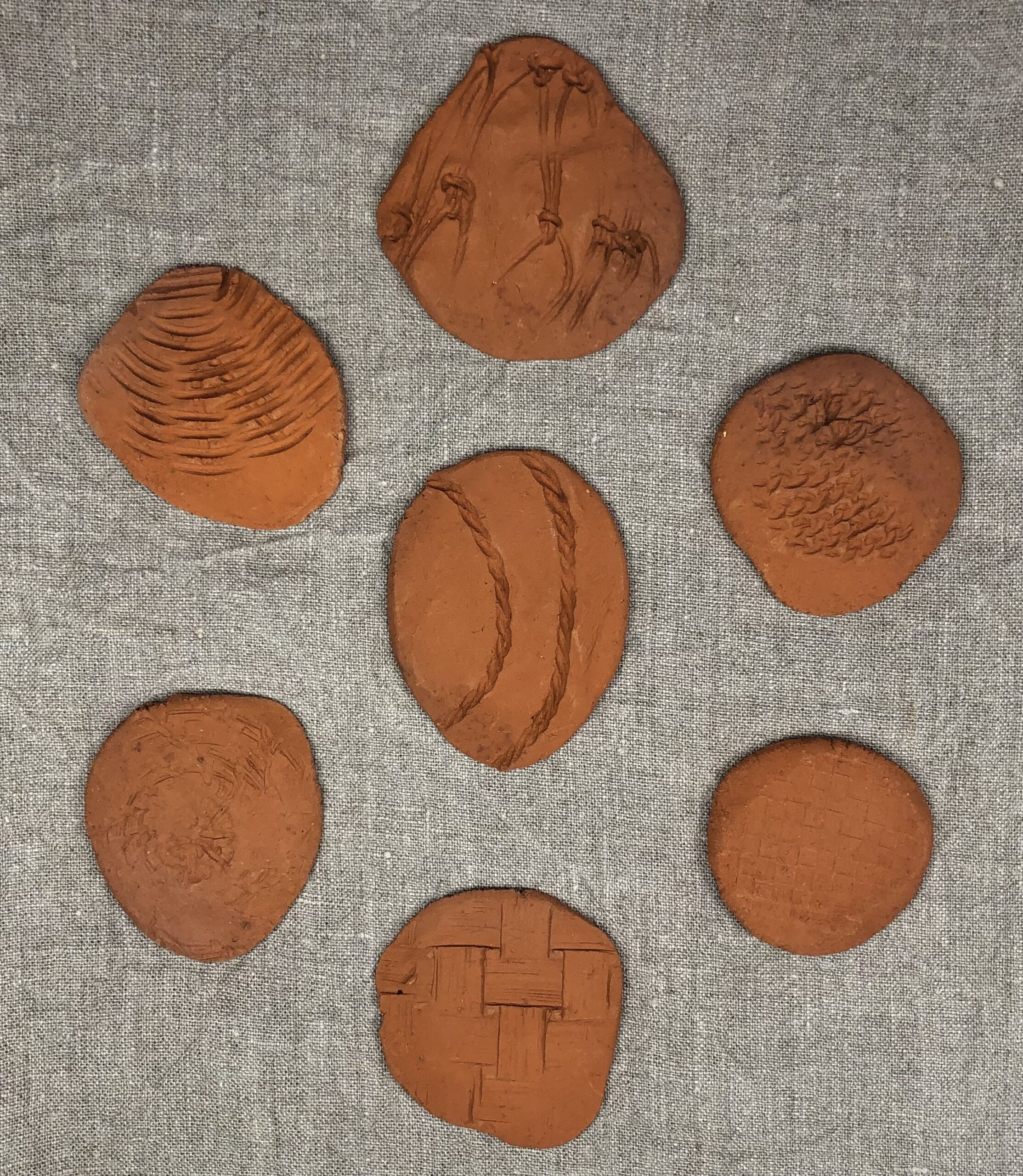
A tiny fragment of a 3-ply cord associated with a Neandertal Levallois flake has recently been found in a context dated 41-52 thousand years ago (Hardy et al., 2020). This is one of the earliest pieces of direct evidence for textiles. Indirect evidence can be seen in wear patterns on bone or shell ornaments (indicating that they were suspended and used as a bead). Because of their fragile nature, textiles rarely survive to be found in the archaeological record. Most that are found are highly fragmentary.

Ideal conditions for textile preservation are cool, dark, and dry (such as a tomb or dry cave), but textiles can occasionally preserve in a variety of relatively extreme situations. These include anaerobic wet conditions, when frozen, or in sites with specific chemical profiles. Textiles from flax and other bast fibers have been found in the sediments at the bottom of lakes and in marshy sites, while protein fibers (wool, hair, silk, and leather) have been found in the highly acidic conditions of peat bogs. Textiles can also survive when partially burned (carbonized), or when encased in salts from the corrosion of metal or if the soils are particularly high in salts. Fabrics made of two different fibers (such as flax and wool) can have “voids” where one of the fibers preserves and the other decays. Depending on circumstances, this can either help or hinder the interpretation.
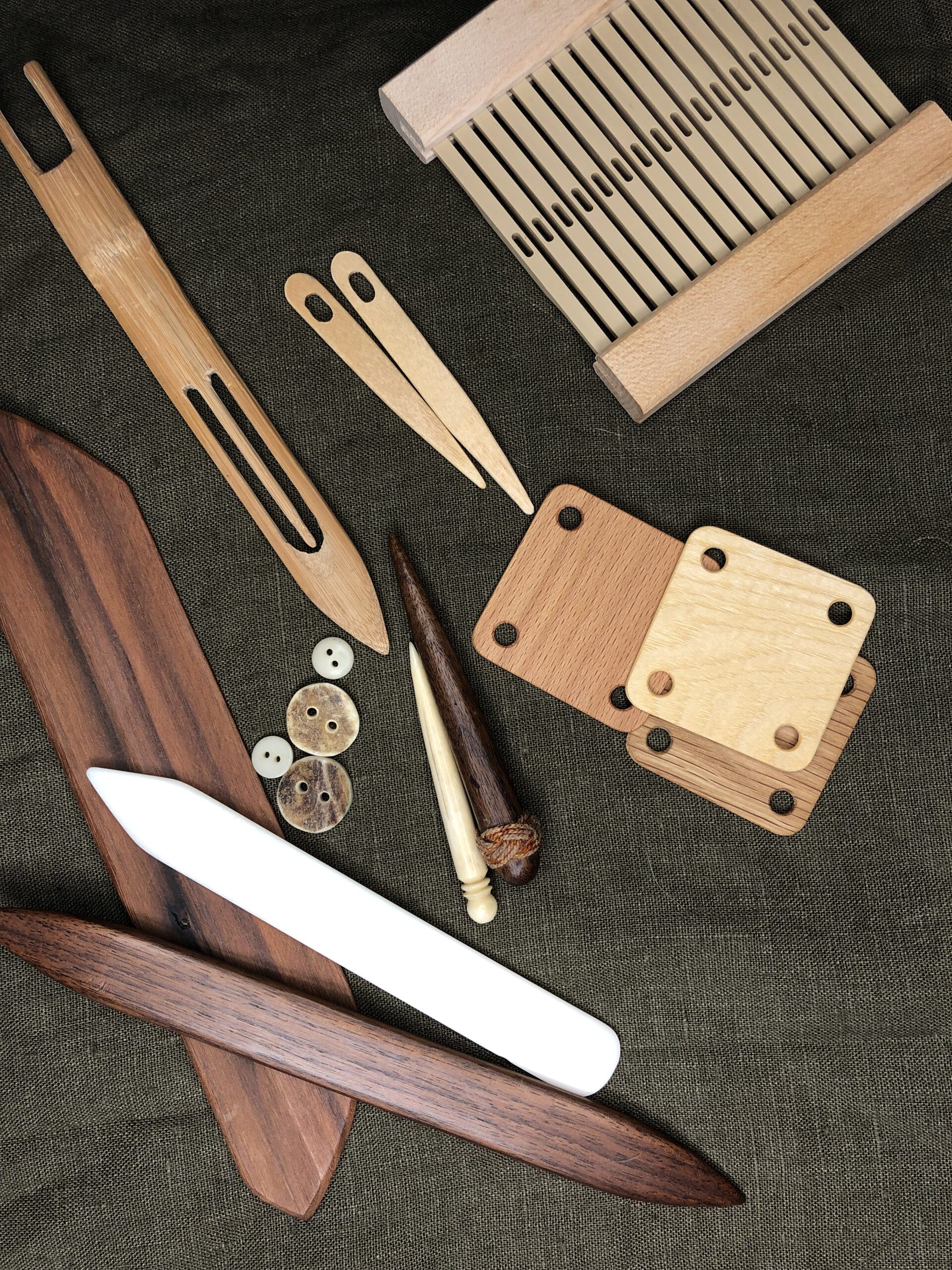
Trace evidence can be studied even when the fabrics themselves have disappeared. Impressions of fabric structures can be found pressed into mud floors or clay pots which later hardened, preserving a record of the structure (Figure 25). These impressions can be studied for clues to the structures of the fabrics themselves.
Other evidence of textiles can be found in the toolkits of the makers. Spindle whorls are found in many sites around the world. These are bead-like weights for the spindles that are used to spin yarn. They come in a wide variety of sizes, shapes, and materials, and these can be reflective of what kind of thread or yarn was being produced (Figure 26). Some whorls are made of repurposed broken pottery, while others are clearly made as spindle whorls. Weights made of fired clay or stone indicate the use of a warp-weighted loom. As with spindle whorls, the loom weights vary in size, shape, and weight, and these can provide hints as to the fabric woven on it. It should be noted that loom weights can be similar to weights used for other purposes such as fishing, so are usually identified from context. Bone awls for poking holes in hides or other materials, bone or wood needles for sewing or nalbinding, or a variety of beaters to manipulate threads on a loom can all be used to demonstrate the presence of textiles even when the textiles themselves don’t survive (Figure 27).
Ancient Technologies
Whether studying lithics, bone tools, ceramics, textiles, foodways, or metals, archaeologists use a variety of techniques to help test their hypotheses. One approach is to look at the ethnographic record for accounts of technologies in action. This is known as ethnoarchaeology. By comparing the evidence left behind by living peoples engaged in these techniques, it’s possible to better interpret the archaeological record. By studying how living peoples interact with their environments and use that knowledge it can help us interpret the past. Keep in mind, though, that living cultures are not some kind of “primitive” relic of the past. While different peoples have developed different technologies, we are all equally human. All human cultures change and adapt to their current situations, and no human culture is any more developed than any other, a fact which must be remembered when creating a research design. Overlapping closely with ethnoarchaeology is another method called experimental archaeology. This approach attempts to replicate the technologies seen in the archaeological record and compare the results with the archaeology.
What is “Experimental Archaeology”?
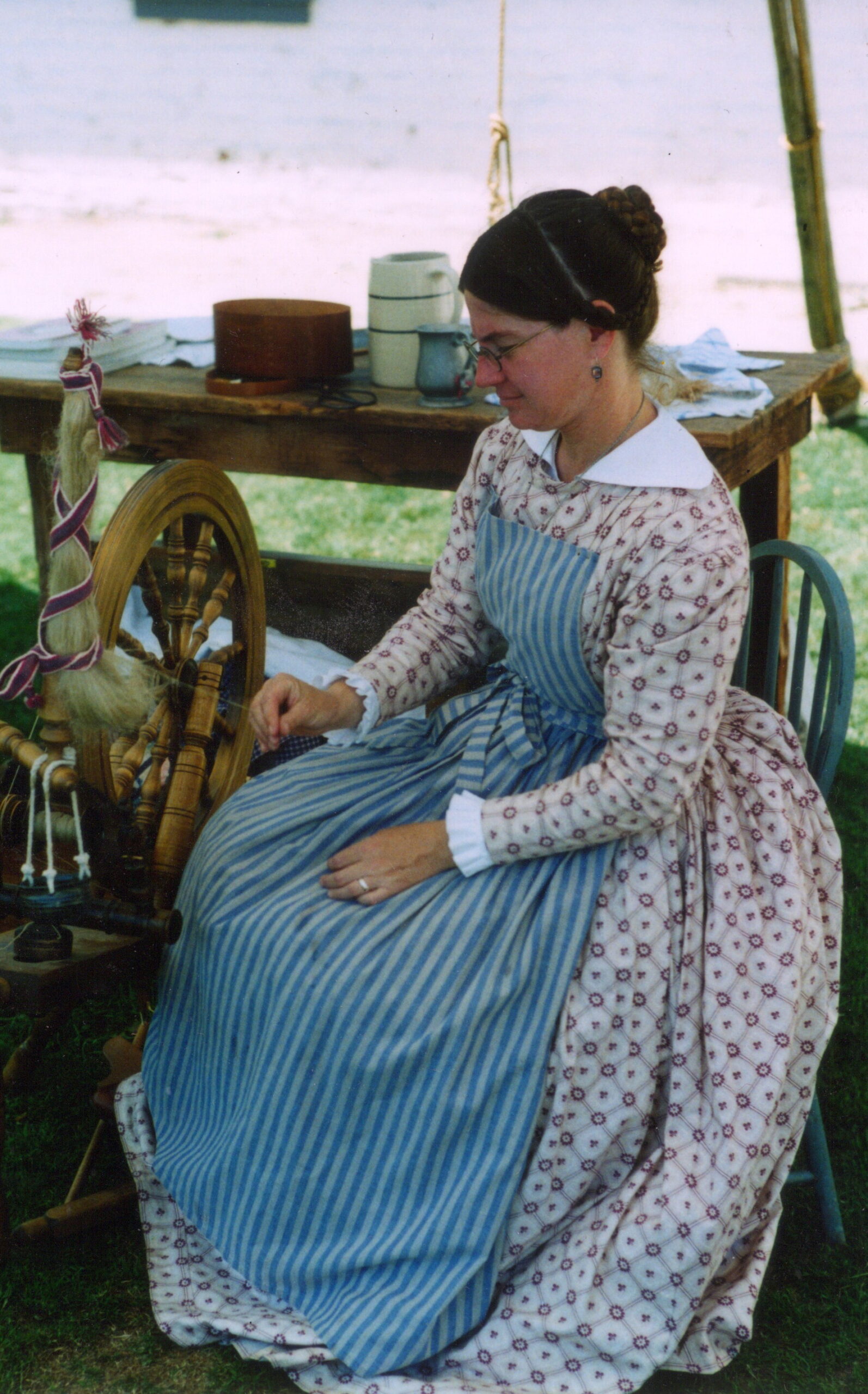
At its core, experimental archaeology is a way of understanding the past through the replication of artifacts and the techniques used to construct them. The experimental archaeologist analyzes and interprets technologies from the archaeological past and attempts to recreate and use them to answer specific questions. We look at the process of manufacture and the waste products that result from that manufacture. We also look at how the artifact is used and analyze wear and breakage patterns. Public outreach in archaeology, which can include television programming, historical re-enactments, and living history interpretations, often include an element of experimental archaeology (Figure 28). In these contexts, the term “experimental archaeology” is rarely used. Instead, the practice is often described as “hands-on history”, or “bringing the past to life” (although both of these terms are themselves misleading).
Experimental archaeology and ethnoarchaeology, in sum, are simply ways to help archaeologists test, think through, and imagine ways in which tools, features, and other remains were made and used.
Experimental Approaches
There are two main aspects of experimental archaeology. The first has to do with the replication of artifacts or (in some cases) entire structures or sites. This involves developing an understanding of the techniques used to both acquire the materials as well as to manufacture the artifact or to construct the site. Ideally, replication would use appropriate techniques and materials for the entire project. That said, few modern people have the necessary skills or the access to necessary tools and materials. There are also time constraints to be considered. Sourcing, gathering, and preparing the materials and making the tools needed to make the artifact or site all add to the time required to replicate an item.
In the past, some parts of the process may have been performed by other specialists. For instance, a clay spindle whorl may not have been made by the spinner who uses the spindle to make thread. Instead, the whorl might have been made by someone familiar with working and firing clay, and then sold or traded to those who use it. Most replications inevitably end up being a compromise between accuracy and expediency. Replicas often are made using substitute materials and/or modern tools for at least a part of the process. As long as the substitutes are chosen with care and clearly documented, the results are still valid.
The second is to use the artifact or site to better understand its function. This allows better interpretation of archaeological finds through analyses of breakage and wear patterns. For instance, an experimental archaeologist may start by creating a replica of a flint blade found at an archaeological site. This provides a basic understanding of the specific artifact and its construction. To better understand stone blades as an artifact type, the next step would be to make a number of replicas and use them to cut a variety of materials. This allows the experimenter to develop an understanding of how the shape of the tool affects its effectiveness. By then examining the wear on the cutting edges of the artifact and the replicas, it may be possible to determine the function of the original.
Conclusion
In this chapter, we have endeavored to show the different ways that archaeologists use objects to better understand the people of the past. Whether archaeologists are focusing on artifacts made from stone, bone, ceramic, metal, or textile, they begin with detailed observations. Some analyses require no specialized equipment whatsoever, while others draw on techniques from chemistry or other physical sciences. As with any study, the specific data that is collected depends on the research questions that are being asked. Hypotheses may be tested through experimental archaeology or ethnoarchaeology. While many of the objects archaeologists analyze may not be the kinds of priceless treasures desired by Indiana Jones, through proper investigation, they all have the potential to teach us a little more about what it means to be human.
Note: This chapter was adapted from a beta version of Traces.
Katrina Worley is a Professor of Anthropology at American River College in Sacramento, California. She learned how to spin as a child when her mother inherited her grandmother’s spinning wheel. When learning to spin on her great-grandmother’s wheel, Katrina asked her mother “what people did before they had spinning wheels”, and was told to “go look it up”. So she did. That led to experimenting with spindles of various kinds, homemade looms, and ultimately to degrees in Anthropology and Archaeology. Her thesis work was on the structures of California Indian textiles other than baskets, and included samples of the techniques identified in the archaeological and ethnographic collections studied. Because textiles are part of a broader pattern of interrelated technologies, she has also dug clay, made spindle whorls and loom weights and fired them in a bonfire, and knapped flint and obsidian blades to work with textile fibers. When not working in archaeological techniques, Katrina spins on an electric spinning wheel, weaves on a floor loom, and enjoys baking.
Jennifer Zovar is Associate Professor of Anthropology at Whatcom Community College in Bellingham, WA. Her academic research has focused in the Bolivian Andes, where she investigated an archaeological site that was occupied just before the Inca came into the region (and after the collapse of the earlier Tiwanaku polity.) Despite regularly telling her students that the ceramic analysis chapter of her dissertation was the most boring thing she’s ever written, she is continually inspired by the way that archaeological analysis of the smallest details can lead us to a more complete understanding of the lives of human beings in the past. In addition to her experience in Bolivia, she has also worked on archaeological projects in Guatemala and across the United States. When she is not researching or teaching anthropology, she loves camping and exploring with her kids and a loyal dog named Hank.
B. Jacob Skousen is an Assistant Professor of Anthropology at Western Illinois University. He has been a professional archaeologist for nearly 15 years, and while most of this experience has been in the North American Midwest, he has archaeological experience in the North American Great Basin and Southwest, Central America, and the Middle East. His research focuses on the Mississippian period, the precontact city of Cahokia, pilgrimage, and identity formation. In the rare moments when not doing archaeology, Jacob enjoys being outside, taking walks, exercising, gardening, and playing the piano.
Part of this chapter is from Traces by Whatcom Community College and is licensed under a Creative Commons Attribution-NonCommercial 4.0 International License, except where otherwise noted.
Further Exploration
Ancient Maya Painted Ceramics, by James Doyle: https://www.metmuseum.org/toah/hd/mayac/hd_mayac.htm
Bone Tools, Smithsonian Museum of Natural History: https://humanorigins.si.edu/evidence/behavior/getting-food/bone-tools
Bronze from Ban Chiang, Thailand: A View from the Laboratory, by Elizabeth Hamilton: https://www.penn.museum/sites/expedition/bronze-from-ban-chiang-thailand/
Elemental Analysis Facility, Field Museum: https://www.fieldmuseum.org/science/labs/elemental-analysis-facility
How Pottery Offers Glimpses into Ancient Foodways, by Carolyn Wilke: https://www.sapiens.org/archaeology/pottery-ancient-food/
Moche Metallurgy: http://precolombino.cl/en/exposiciones/exposicion-permanente-america-precolombina-en-el-arte/andes-centrales/vitrina-metalurgia-moche/
Mystery of the Varna Gold, by Andrew Curry: https://www.smithsonianmag.com/travel/varna-bulgaria-gold-graves-social-hierarchy-prehistoric-archaelogy-smithsonian-journeys-travel-quarterly-180958733/
Tool Use, a video from the Jane Goodal Institute: https://vimeo.com/5004514
What was the Venus de Milo Doing with Her Arms?, by Virginia Postrel: http://www.slate.com/articles/arts/culturebox/2015/05/the_venus_de_milo_s_arms_3d_printing_the_ancient_sculpture_spinning_thread.html
References
Biagi, P., & Starnini, E. (2014). The Levallois Mousterian Assemblages of Sindh (Pakistan) and Their Relations with the Middle Paleolithic of the Indian Subcontinent. Archaeology Ethnology & Anthropology of Eurasia 42:18-32.
Borck, L., Athenstädt, J. C., Cheromiah, L. A., Aragon, L. D., Brandes, U., & Hofman, C. L. (2020). Plainware and Polychrome: Quantifying Perceptual Differences in Ceramic Classification between Diverse Groups to Further a Strong Objectivity. Journal of Computer Applications in Archaeology 3(1): 135-150. http://doi.org/10.5334/jcaa.37
Bradfield, J., Forssman, T., Spindler, L., & Antonites, A. (2019). Identifying the animal species used to manufacture bone arrowheads in South Africa. Archaeological and Anthropological Sciences 11: 4219-2434. https://doi.org/10.1007/s12520-018-0688-5
Craig, O. E., Shillito, L., Albarella, U., Viner-Daniels, S., Chan, B., Cleal, R., Ixer, R., Jay, M., Marshall, P., Simmons, E., Wright, E., and Parker-Pearson, M. (2015). Feeding Stonehenge: Cuisine and Consumption at the Late Neolithic site of Durrington Walls. Antiquity 89(347): 1096-1109. doi:10.15184/aqy.2015.110
Fagg Rackham, A., Franke, G., Junius, H., Männel, T. M. & Beck, C. (2017). Early West African Iron Smelting: The Legacy of Taruga in Light of Recent Nok Research. African Archaeological Review 34: 321-343. doi: 10.1007/s10437-017-9262-2
Fasquelle, R. A., Sheets, P., & Taubeo, K. A. (2016). Protecting sacred space: Rosalila’s eccentric chert cache at Copan and eccentrics among the Classic Maya. Precolumbia Mesoweb Press.
Graff, S. R. (2020). Archaeology of Cuisine and Cooking. Annual Review of Anthropology 49: 337-354.
Hallett, E., Marean, C., Steele, T., Álvarez-Fernández, E., Jacobs, Z., Cerasoni, J.N., Aldeias, V., Scerri E., Olszewski, D., El Hajraoiu, M.A., & Dibble, H. (2021). A worked bone assemblage from 120,000-90,000 year old deposits at Contrebandiers Cave, Atlantic Coast, Morocco. iScience 24(9). https://doi.org/10.1016/j.isci.2021.102988
Janusek, J. W. & Williams, P. R. (2016). Telluric Techné and the Lithic Production of Tiwanaku. In Making Value, Making Meaning: Techné in the Pre-Columbian World, edited by C. L. Costin, pp. 95-128. Dumbarton Oaks.
Kanjanajuntorn, P. (2020). The Three-Age System: A Struggle for Southeast Asian Prehistoric Periodisation. SPAFA Journal 4. https://doi.org/10.26721/spafajournal.v4i0.623
Keeley, L. H. (1980). Experimental determination of stone tool use: A micro-wear analysis. University of Chicago Press.
Kennett, D. J., Sakai, S., Neff, H., Gossett, R., & Larson, D.O. (2002). Compositional Characterization of Prehistoric Ceramics: A New Approach. Journal of Archaeological Science 29:443-455.
Kim, N. C. & Kusimba, C. M. (2008). Pathways to Social Complexity and State Formation in the Southern Zambezian Region. African Archaeological Review 25: 131-152. doi: 10.1007/s10437-008-9031-3
Langley, M.C., Balme, J., & O’Conner, S. (2021). Bone artifacts from Riwi Cave, south-central Kimberley: Reappraisal of the timing and role of osseous artifacts in northern Australia. International Journal of Osteoarchaeology 1-10. https://doi.org/10.1002/oa.2981
Lechtman H. (2014). Andean Metallurgy in Prehistory. In: Roberts B., Thornton C. (eds) Archaeometallurgy in Global Perspective. Pp. 361-442. Springer. https://doi.org/10.1007/978-1-4614-9017-3_15
Lemorini, C., Plummer, T., Braun, D., Crittenden, A., Ditchfield, P., Bishop, L., Hertel, F., Oliver, J., Marlowe, F., Schoeninger, M., & Potts, R. (2014). Old Stones’ Song: Use-wear Experiments and Analysis of the Oldowan Quartz and Quartzite Assemblage from Kanjera South (Kenya). Journal of Human Evolution 72:10-25.
Lepre, C., Roche, H., Kent, D., Harmand, S., Quinn, R., Brugal, J., Texier, P., Lenoble, A., & Feibel, C. (2011). An Earlier Origin for the Acheulian. Nature 477:82-85.
McClure, S. B., Magill, C., Podrug, E., Moore, A. M. T., Harper, T. K., Culleton, B. J., Kennett, D. J., Freeman, K. H. (2018). Fatty acid specific δ13C values reveal earliest Mediterranean cheese production 7,200 years ago. PLoS ONE 13(9): e0202807. https://doi.org/10.1371/journal.pone.0202807
Morgan, T., Uomini, N., Rendell, L., Chouinard-Thuly, L., Street, S., Lewis, H., Cross, C., Evans, C., Kearney, R., de la Torre, I., Whiten, A., & Laland, K. (2015). Experimental evidence for the co-evolution of hominin tool-making teaching and language. Nature Communications 6(6029). https://doi.org/10.1038/ncomms7029
Pikirayi, I. & Lindahl, A. (2013). Ceramics, Ethnohistory, and Ethnography: Locating Meaning in Southern African Iron Age Ceramic Assemblages. The African Archaeological Review 30(4): 455-473. https://doi.org/10.1007/s10437-013-9145-0
Radivojević, M., Rehren, T., Kuzmanovic-Cvetkovi, J., Jovanovic, M., & Northover, J. P. (2013). Tainted ores and the rise of tin bronzes in Eurasia, c. 6500 years ago. Antiquity 87: 1030-1045.
Reents-Budet, D. (1994). Painting the Maya Universe: Royal Ceramics of the Classic Period. Duke University Press.
Rice, P. (1987). Pottery Analysis: A Sourcebook. University of Chicago Press.
Rye, O. (1981). Pottery Technology: Principles and Reconstructions. Taraxacum, Inc.
Sahle, Y., & Gossa T. (2019). More data needed for claims about the earliest Oldowan artifacts. Proceedings of the National Academy of Sciences, 116(41), 20259-20260. www.pnas.org/cgi/doi/10.1073/pnas.1911658116.
Shea, J. (2015) Stone Tools in the Paleolithic and Neolithic Near East: A Guide. Cambridge University Press, New York.
Sinopoli, C. (1991) Approaches to Archaeological Ceramics. Plenum Press.
Smallwood, A. M., & Thomas A. Jennings, T. A. (Eds.). (2015). Clovis: On the edge of a new understanding. Texas A&M University Press.
Trubitt, M. B. (2005). Crafting Marine Shell Prestige Goods at Cahokia. North American Archaeologist 26(3): 249-266.
Turq, A., Roebroeks, W., Bourguignon, L., & Faivre, J. (2013) The Fragmented Character of Middle Palaeolithic Stone Tool Technology. Journal of Human Evolution 65:641-655.
Wu, X., Zhang, W., Goldberg, P., Cohen, D., Pan, Y., Arpin, T., & Bar-Yosef, O. (2012). Early Pottery at 20,000 Years Ago in Xianrendong Cave, China. Science 336(6089), 1696-1700. DOI: 10.1126/science.1218643
Zhu, J., MacDonald, B. L., Hang, T., Zhu, Z., & Glascock, M. D. (2019). Compositional characterization of Zisha clay from the Yixing area (Jiangsu, China) by neutron activation analysis. Microchemical Journal 147, 1117-1122. https://doi.org/10.1016/j.microc.2019.04.031
Zovar, J. (2012). Post-Collapse Constructions of Community, Memory, and Identity: An Archaeological Analysis of Late Intermediate Period Community Formation in Bolivia’s Desaguadero Valley. [Doctoral dissertation, Vanderbilt University]. Vanderbilt University Institutional Repository. https://etd.library.vanderbilt.edu/etd-08012012-131813
Zupancich, A., Solodenko, N., Rosenberg-Yefet, T., & Barkai, R. (2018) On the Function of Late Acheulean Stone Tools: New Data from Three Specific Archaeological Contexts at the Lower Palaeolithic Site of Revadim, Israel. Lithic Technology 43:255-268.
An object that was made and used by humans in the past.
An approach through which archaeologists may attempt to replicate the manufacture or use of artifacts in order to test hypotheses about their role in the past.
An approach through which archaeologists observe living peoples with similar material culture in order to test hypotheses about how objects were made or used in the past.
An object that is made for a specific purpose. Tools are generally characteristic of humans although some animals are also known to make and use tools.
Stone tools and the waste material from their creation.
A grouping or classification of different objects based on predetermined criteria.
The earliest type of lithic artifacts, roughly-flaked butchering elements that were made by our earliest human ancestors at least 2.6 million years ago.
Stone tools that are made from sedimentary, igneous, or metamorphic rock and shaped by pecking or grinding
A type of fine-grained sedimentary rock that flakes easily and is often used for stone tools. Also known as flint.
Naturally occurring volcanic glass, which flakes well to a very sharp edge and is often used for stone tools.
When used in reference to lithics, a core is the base material from which flakes are chipped in order to make stone tools.
When used in reference to lithics, a flake is the long linear sliver of stone removed from the core, which can be used as a tool itself or further shaped into a scraper, knife, projectile point, or other chipped-stone tool.
A weight, often in a teardrop shape, which may have been attached to fishing nets to help them sink.
The handstone used to grind food against a metate (lapstone).
The lapstone that the mano (handstone) grinds against.
The waste produced when making a chipped-stone tool.
The blocky fragments of chipped stone material created from the hammer crushing the parent material during the flaking process.
When used in reference to lithics, a Clovis point is a fluted lanceolate spearpoint found throughout North America and dating from between roughly 12,000 and 11,000 BCE.
When used in reference to lithics, a fluted point is one that has had a long flake removed from both sides at the base, which would have made it easier to haft to a spear or other projectile.
The small signs of usewear that often occur along the edge of a tool. Since different uses lead to different wear patterns, a microwear analysis can help archaeologists better understand how a tool was used.
A tool used for grinding, smoothing, or polishing, which could be used to shape bone and shell implements.
A term which is used to refer to the period of the Ice Age in North America following standard archaeological chronology. The Clovis point dates to the Paleoindian period.
A pointed tool used for punching holes, often as a part of leather work.
The bone commonly known as the shoulder blade, found in most animals.
In an archaeological context, any material made by humans out of clay and subsequently fired so that the clay chemically changes and hardens.
In reference to ceramics, this refers to heating the clay so that it chemically changes and hardens.
Small statuettes of women found across Europe from approximately 35,000-20,000 years ago.
Short for potsherds, referring to the broken pieces of pottery found at archaeological sites.
The process through which plants and animals change biologically as a result of human interference, becoming dependent on humans at the same time that humans become dependent on them.
The practice of permanently living in one place (usually in villages, towns, or cities) as opposed to following a more nomadic lifestyle.
When used in reference to ceramics, material that is intentionally added to the clay to prepare it for different uses. Temper can include quartz and other minerals; grasses or other organic materials; or ground shell, bone, or pottery fragments.
A kind of oven where the heat is produced in a firebox and flows either up or down into a chamber where the pottery sits.
A technique in which thin sections of the ceramic are viewed under a microscope in order to identify the minerals within the clay matrix or additional inclusions.
The place of origin or source of an artifact or material.
A statistical tool used to create or test groupings of objects.
A dating method which measures accumulated radiation since the last time a material has been heated. When used on ceramics, this will usually provide the approximate date that the piece was initially fired.
The study of metal in archaeological contexts
Metals that can be found in nature in a pure, metallic form (e.g. gold, copper, silver)
A metallic compound, formed through the mixing of two or more metals.
A technique that measures X-ray photons to characterize different materials.
A technique used to analyze the mass of different molecules in a sample
The process of cutting the wool off of a sheep or similar animal.
Plied yarn is yarn that is made of two or more single strands of yarn twisted together.
In weaving, the set of threads that runs the length of the fabric.
In weaving, the set of threads that runs from side-to-side along the fabric, at right angles with the warp.
An ancient technique used for garments in many parts of Northern Europe, made of a structure of interlinked loops formed using a wooden or bone needle.
A form of plaiting or braiding with a fixed warp, used to create elastic fabrics for hairnets and similar items.
Bead-like weights for the spindles that are used to spin yarn. They come in a wide variety of sizes, shapes, and materials.

